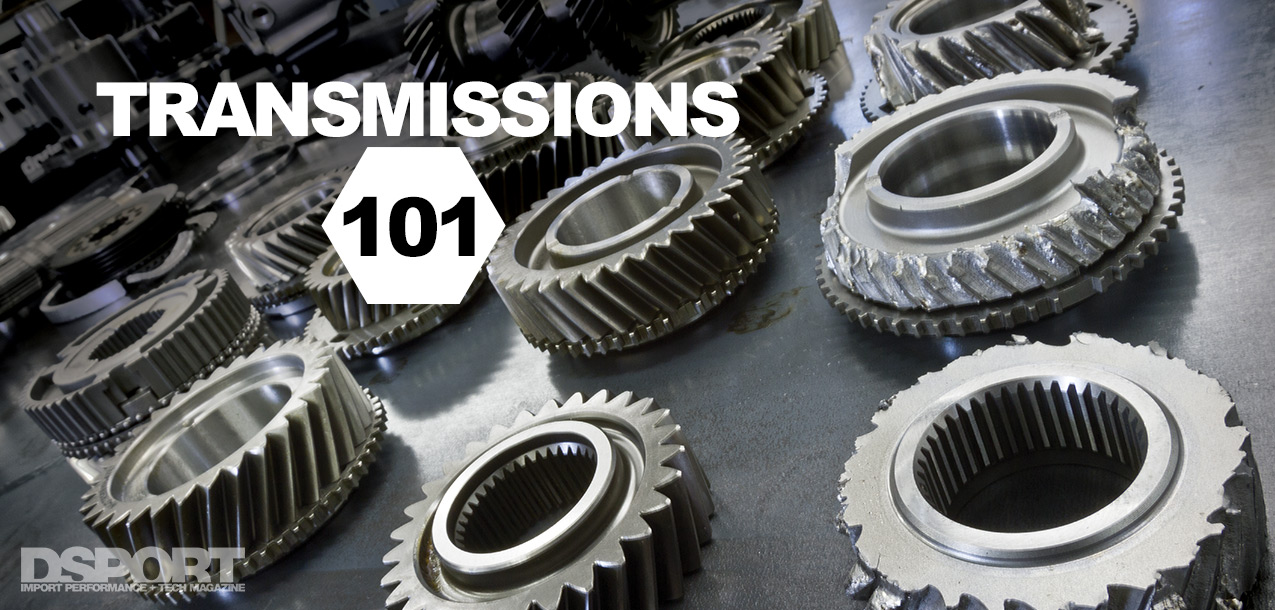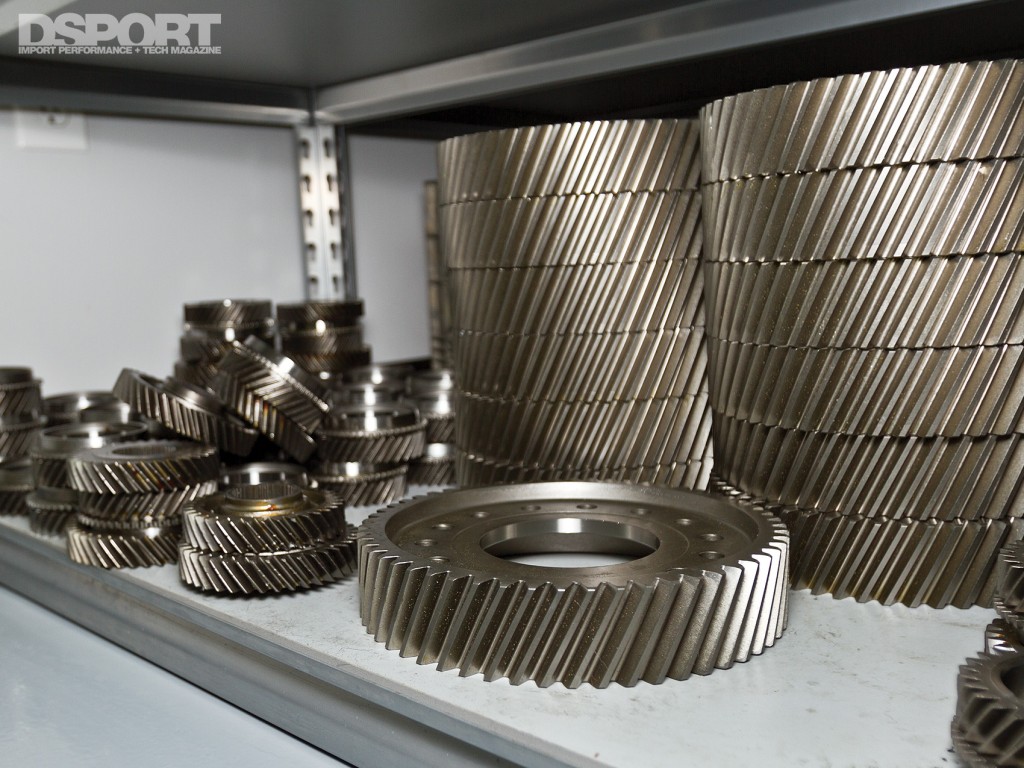In the U.S., most enthusiasts don’t think about upgrading their vehicle’s transmission until it becomes absolutely necessary. By absolutely necessary, we mean the point at which the engine produces more torque than the transmission can handle. The end result is often broken shafts, bent forks and worn synchros. In Japan and elsewhere, a number of enthusiasts upgrade the vehicle’s transmission to not only handle additional power, but also to optimize the transmission’s gear ratios for increased performance. Acceleration is improved as the engine spends more time in the sweet-spot of the power band. While this doesn’t affect the peak horsepower getting to the ground, the average horsepower put to the ground is increased. The end result is improved acceleration for quicker 0-60, quarter mile or lap times.
Text by Richard Fong & Michael Ferrara // Photos by DSPORT Staff
DSPORT Issue #148
Numbers Game
Transmission gear ratios are a function of the ratio between the input shaft and output shaft speeds. Inside the transmission, an input shaft, intermediate shaft and output shaft use an assortment of gears with different teeth counts to establish the transmission ratios. To simplify this lesson, imagine a transmission where the gears on the intermediate shaft (first through fifth) always have the same number of teeth as the gears (first through fifth) on the input shaft. Thus, the only purpose served by the intermediate shaft is to allow the input shaft and output shaft to rotate in the same direction.
Now take a look at first on this imaginary transmission. The input gear has 12 teeth and the output gear has 36 teeth. In this case, the input shaft would need to spin three times (36/12=3.0) for every revolution of the output shaft. This would illustrate a first gear with a 3.0:1 or 3-to-1 ratio. This three-to-one ratio would multiply the torque from the engine by a factor of three to help the vehicle accelerate quickly from a stop. Of course, speed would be limited by this ratio. When the engine is spinning at 6,000 RPM (the input shaft is also spinning at this speed), the output shaft of the transmission would only be at 6,000/3.0 or 2,000 RPM. At 2,000 RPM shaft speed our imaginary car may only be able to reach 45 MPH at 6,000 RPM of engine speed in first. Now, let’s say that fifth gear in this same transmission is “1-to-1”. This is another way of saying that fifth gear has a 1.0:1 transmission ratio. In this case, the number of teeth on both the input and output shaft gear when fifth is selected would be equal. The input shaft at 6,000 RPM in fifth would result in an output shaft also at 6,000 RPM. Since the output shaft is spinning three times as fast as first gear, the speed will also be three times as much. In this case 45 MPH x3 or 135 MPH. Obviously the gears between first and fifth in our imaginary transmission would have ratios that progressed between 3.0-to-1 (first) and 1.0-to-1 (fifth).
Close-Ratio vs. Wide-Ratio Transmission
Close-ratio aftermarket gear sets are offered for most of the popular Japanese performance vehicles. This allows a factory transmission to be upgraded with a gear set that generally handles more power and provides more performance-friendly ratios. A close-ratio transmission has ratios for each gear that are closer to each other when compared to a wider-ratio transmission. If Transmission A has the following ratios for first through fifth or 2.6:1, 2.2:1, 1.8:1, 1.4:1 and 1:1 (a ratio difference of 0.4:1 between each gear) and Transmission B has 3.0:1, 2.5:1, 2.0:1, 1.5:1 and 1:1 ratios for first through fifth (a ratio difference of 0.5:1 between each gear); Transmission A would be considered a closer-ratio transmission than Transmission B.
So what’s the advantage of having close ratios in the transmission? Close-ratio transmissions produce less RPM drop between gear shifts. In the above examples, an 8,000 RPM shift from first to second would result in a drop in engine speed to 6,770 RPM with the close-ratio transmission or 6,670 RPM with the wide-ratio transmission. Maybe not a big deal on the 1-2 shift, but look at the 3-4 shift. The engine speed at an 8,000RPM shift would drop to 6,220 RPM in the close-ratio example or to 6,000 RPM on the wide-ratio transmission. Depending on the shape of the engine’s power curve, the RPM difference may mean that the engine is down a measurable amount of power on the gear shift.
So why aren’t all transmissions close ratio? To be a closer-ratio transmission than the factory offering, at least one of two parameters must be changed. Either the first gear ratio must be set to a lower numeric ratio (reduced from a 3.0:1 to a 2.6:1 ratio) and/or the last gear ratio (fourth in a 4-speed, fifth in a 5-speed, etc…) must be set to a higher numeric gear ratio (raised from a 1.0:1 to a 1.2:1 ratio). In the end, the spread between the first and last gear on the transmission determines whether one transmission is a closer-ratio transmission to another. So what happens when first gear is set to a lower numeric ratio? The result is that less torque is transferred to the drive wheels while the maximum speed in first is increased. Since modified gear sets are most often used in vehicles with modified engines that produce more torque, nearly all aftermarket close- ratio gear sets establish first gear at a lower numeric ratio than the stock transmission. Some aftermarket transmission gear sets also adjust the last gear ratio to a higher numeric ratio. The tradeoff with that approach is a reduction in the top-speed capability of the vehicle.
What’s wrong with the factory gear ratios? The gear ratios in stock transmissions are often optimized for fuel economy. Many times the same gear ratio transmission may be used in a number of different platforms to keep manufacturing costs at a minimum. In most cases, it’s unlikely that the gear ratio selection in the stock transmission has been optimized for maximum performance.




